
By Debra Simon and Brack Johnson
Just one year ago, we were reveling in a journey to our neighbor to the north. We're reprinting the article now both as an idyllic memory and a promise of travel in the future.
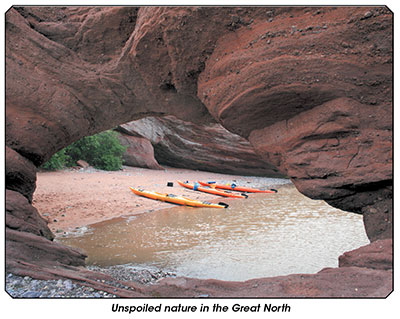 While the Triangle was sweltering this summer, we leapt out of the rat race, jumped behind the wheel and motored up the East Coast until our car reached cool weather. And another country.
While the Triangle was sweltering this summer, we leapt out of the rat race, jumped behind the wheel and motored up the East Coast until our car reached cool weather. And another country.
Wherever we drove in Canada, it seemed there were four things:
1. Tim Hortons, a fast-food chain as ubiquitous as Dunkin' in America.
2. Maple products.
3. Ice cream.
4. "Beware of Moose" signs.
Immediately, we signed up for Tim Rewards and used the card for coffee every day until we were granted a free cup of java. Goal!
When not draining coffee, we devoured maple ice cream and other local comestibles. Excited about meeting Bullwinkle, we kept watch. For one whole month. But he never showed.
Where We Stayed
New Brunswick
The Algonquin Resort –
St. Andrews By-the-Sea
algonquinresort.com
Four Points by Sheraton – Moncton marriott.com/hotels/travel/yqmfp-four-points-moncton
Prince Edward Island
Banbridge Inn – Charlottetown
banbridgeinn.com
Nova Scotia
The Resort at Cabot Links – Inverness
cabotlinks.com/resort/
Silver Dart Lodge – Baddeck
silverdartlodge.com
Glenora Inn & Distillery –
Glenville
glenoradistillery.com/the-inn
Quebec
Les Chalets du Parc –
Penouille, Gaspe Peninsula
chaletsduparc.com/en
Hotel & CIE – Sainte-Anne-
de-Monts, Gaspe Peninsula
hoteletcie.com/en
Auberge Saint-Antoine –
Quebec City
saint-antoine.com
Hotel Le Crystal –
Montreal
hotellecrystal.com
Adirondacks
Mirror Lake Inn –
Lake Placid
mirrorlakeinn.com
That was the only bummer in a peaceful road trip full of adorable coastal villages, lovely people, astonishing sunsets, fresh seafood, French cities, Scottish-accented highlands, music, lighthouses and, due to favorable exchange rates, 25% off all we bought.
It took no time to get used to the bilingual nation. Many Canadians, particularly in the service industry, switched seamlessly between languages.
In remote French-speaking areas, people with little facility in English tried hard to comprehend our clumsy high-school class attempts at their language.
A convenience store clerk, baffled by our broken French, couldn't understand our request to be directed to the restroom. Desperate, we ran to the shelves and picked up a pack of Charmin, prompting guffaws and needed directions.
Bathrooms, always important on the trail, were clean even in out-of-the-way gas stations.
Other things with which we quickly fell in love: one- and two-dollar coins (loonies and toonies); harbor cruising, whale-watching and other sea hullabaloo; warm-weather festivals; al fresco meals in humble bars and fine restaurants alike; and splendid views in every direction.
Our international journey began as we crossed the border from Calais, Maine into the maritime Canadian province of New Brunswick, where the farmland of the Saint John River Valley leads to the Bay of Fundy, known for cliffs, coves and the globe's highest tides.
New Brunswick
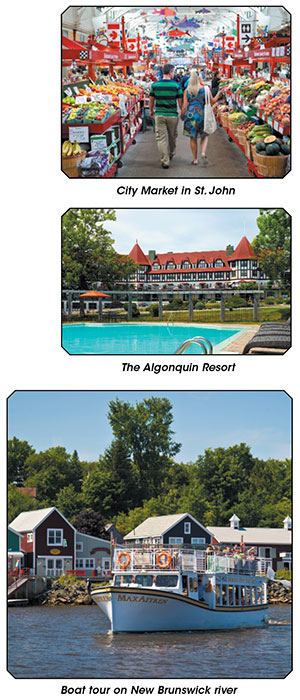 The picturesque town of St. Andrews By-the-Sea boasts more than 200 houses over a century old. Water Street, the main thoroughfare, is lined with restaurants, shops and galleries along – you guessed it – the water.
The picturesque town of St. Andrews By-the-Sea boasts more than 200 houses over a century old. Water Street, the main thoroughfare, is lined with restaurants, shops and galleries along – you guessed it – the water.
We happened to get there on Canada Day, equivalent to July Fourth here, when musicians were playing on the piers and fireworks lit up the sky. Although it was a major holiday, we had no problem snagging a last-minute table on the balcony of a coffee shop to watch a pink-and-orange sunset followed by pyrotechnic displays.
The well-heeled have been summering at The Algonquin Resort since 1899, so we gave it a whirl for one night. Restored to its original splendor and outfitted with modern amenities, this grand dame presents manicured gardens, tennis courts, indoor and outdoor pools, a spa, a golf course and generous verandas, where we delighted in evening cocktails and breakfast the next morning.
The adventure continued north through St. John, an urban center on the Bay of Fundy, where we watched ships steam into the harbor, surveyed vibrant sculptures of salmon on street corners, and browsed food and craft stalls in City Market.
Hopping back on the road, we recharged with a restful night at the Four Points Sheraton in Moncton. The next day, we stocked up on supplies before traversing one of the world's longest bridges (47.75 Canada dollar toll! – but only when leaving) to Prince Edward Island.
Prince Edward Island
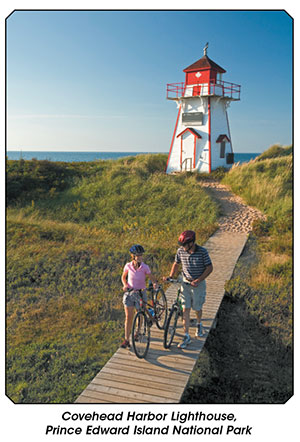 PEI, or The Island, is so pretty. Imagine the green, rolling hills of rural North Carolina and then surround them with the solitude and water of the Outer Banks.
PEI, or The Island, is so pretty. Imagine the green, rolling hills of rural North Carolina and then surround them with the solitude and water of the Outer Banks.
Only 139 miles from tip to tip, the crescent-shaped island has 63 lighthouses and no billboards. Fishing villages – not touristy replicas, but places where real workers push off from the docks each morning to earn a living from the sea – abound.
Although our visit happened in tourist season, we enjoyed pure relaxation. Circling the island, we found vehicular traffic was sparse and unhurried. Nobody honked a car horn. At intersections, we were always let in.
Even the province's condensed version of Myrtle Beach, in the town of Cavendish, is not so much honky-tonk as cotton candy. It's also the setting for the warm-hearted 1908 novel "Anne of Green Gables" by Lucy Maud Montgomery. For fans, there are many must-see spots.
We spent magical days sauntering along beaches; scrambling around lighthouses; popping into country stores; and looking through galleries, many of which were helmed by the artists themselves.
Our nights were absorbed with chowing down on "lobster suppers," typically a crustacean plus all-you-can-fit chowder, mussels, salad, bread and dessert; listening to live Celtic music; and chomping on popcorn from the snack bar while watching movies at the Brackley Drive-in Theatre, returned to its 1950s glory.
The pace was still gentle in the attractive provincial capital of Charlottetown with its tree-lined colonial and Victorian streets.
We stayed in a thoughtfully equipped one-bedroom apartment with a kitchen in the Banbridge Inn, which has been family run since 1967. Homey, spotless and situated on five acres, the motel put us close to all the hot spots, including the cheerful city center and PEI National Park, which features sand dunes and red sandstone cliffs.
Nova Scotia
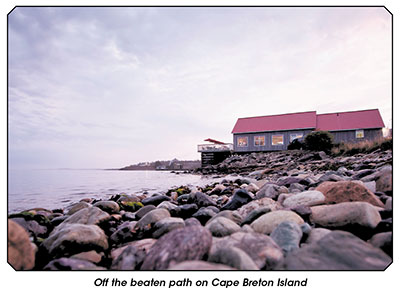 The calm never ceased as we traveled the toughest, highest and most isolated region of Novia Scotia: Cape Breton Island. The interior contains mountains, valleys, rivers and lakes; the rocky and rugged coast is dotted with endless bays and inlets; Much of the fairy tale land is undeveloped, and it's never more than 35 miles from the ocean.
The calm never ceased as we traveled the toughest, highest and most isolated region of Novia Scotia: Cape Breton Island. The interior contains mountains, valleys, rivers and lakes; the rocky and rugged coast is dotted with endless bays and inlets; Much of the fairy tale land is undeveloped, and it's never more than 35 miles from the ocean.
We were reminded of the Scottish Highlands, from which many people emigrated more than 200 years ago. Some descendants retain a Gaelic accent. Other people parle francais. All the residents are soft-spoken and unfailingly polite.
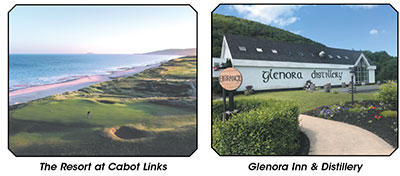 In the Cape Breton Highlands, an extension of the Appalachian Mountains chain (which runs from Canada through North Carolina and down to Alabama), most visitors plan active holidays - cycling, canoeing, kayaking, hiking, diving, bird watching or fishing.
In the Cape Breton Highlands, an extension of the Appalachian Mountains chain (which runs from Canada through North Carolina and down to Alabama), most visitors plan active holidays - cycling, canoeing, kayaking, hiking, diving, bird watching or fishing.
We had a blast driving its 186-mile Cabot Trail through Cape Breton Highlands National Park. The scenic highway winds along the shoreline, across plains and between mountains then zigzags through switchbacks before descending to Pleasant Bay on the shores of the Gulf of St. Lawrence.
 At the Red Shoe Pub in the hamlet of Mabou, we dug into plates of fish and chips and steamed mussels with Irish soda bread as a duo played Gaelic music while pub-goers hoofed it. The folk music and dancing were authentically entertaining, and we sought them out again and again. Fortunately, we were on the Ceilidh ("party") Trail, and merrymaking was offered in venues large and small.
At the Red Shoe Pub in the hamlet of Mabou, we dug into plates of fish and chips and steamed mussels with Irish soda bread as a duo played Gaelic music while pub-goers hoofed it. The folk music and dancing were authentically entertaining, and we sought them out again and again. Fortunately, we were on the Ceilidh ("party") Trail, and merrymaking was offered in venues large and small.
In the adjoining town of Inverness, a modest burg that plays host to an exclusive golf course, there's a walkway along the beach and pilot whales can sometimes be seen off the coast.
Our stylish room at The Resort at Cabot Links afforded a front-row seat to the undulating links, which followed the contours of the sand dunes, as well as the shimmering blue water beyond.
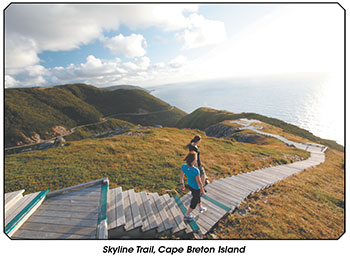 Golfers fly in from far and wide to try their luck at two distinctive courses beside the ocean.
Golfers fly in from far and wide to try their luck at two distinctive courses beside the ocean.
Nearby Glenville is the proud home of the Glenora Inn & Distillery, where North America's only single-malt Scotch is created. The flower-filled grounds are captivating, and the brook that's used to make the whiskey runs through it.
Our stopover included a tour of the distillery, an enchanting dinner; thirst-quenchers by the gardens; and a night in a newly built, state-of-the art room.
About an hour away on the Cabot Trail, we pulled into the Silver Dart Lodge, which is next to the Bras d'Or Lakes in Baddeck, a resort town in a bucolic setting. Our room was cozy and clean, and the staff was friendly and helpful.
They pointed us to the Alexander Graham Bell National Historic Site, which is dedicated to the work of the inventor, who had a home in Baddeck. The museum covers Bell's incredibly varied innovations and experiments – not just the telephone, but medical and electrical devices, farm technology, kites and airplanes.
Next up, a schlep of 12 hours in one day to get to the province of Quebec. Twelve hours?!? Who planned this expedition? Oh, yeah, we did.
Quebec
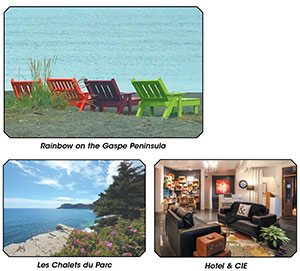 Our sojourn in the province of Quebec provided two completely different experiences. One was overwhelming serenity as we reconnoitered the panoramic Gaspe Peninsula, a rounded chunk of land that protrudes into the Gulf of St. Lawrence. The other was quickened pulses from dropping into the big arms of Quebec City and Montreal.
Our sojourn in the province of Quebec provided two completely different experiences. One was overwhelming serenity as we reconnoitered the panoramic Gaspe Peninsula, a rounded chunk of land that protrudes into the Gulf of St. Lawrence. The other was quickened pulses from dropping into the big arms of Quebec City and Montreal.
In the rough coastline of the Gaspe, there are long stretches of magnificent scenery in which signs of civilization are rare. The region is so far-flung that there are still telephone booths in case someone gets stuck. On two occasions, drivers of 18-wheelers waved down our car to ask us for directions to the closest town.
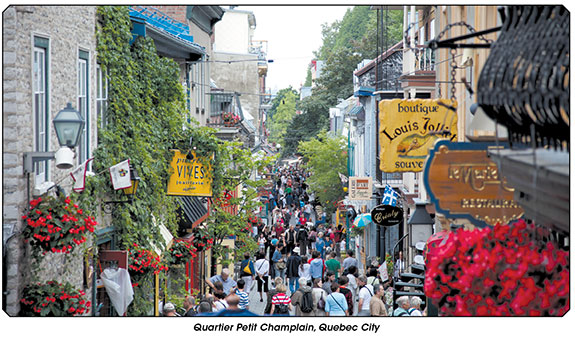
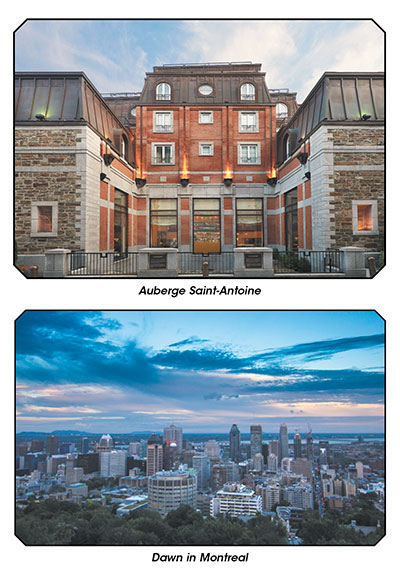 For our part, we were often thrilled to come across a gas station or convenience store (which, since we were in the French part of Canada, supplied pâté in addition to beef jerky). In one town, the only laundromat was at a small college – and everyone was invited to use it.
For our part, we were often thrilled to come across a gas station or convenience store (which, since we were in the French part of Canada, supplied pâté in addition to beef jerky). In one town, the only laundromat was at a small college – and everyone was invited to use it.
Our initial lodgings were at the 32-cottage Les Chalets du Park on Gaspe Bay along the shore of Penouille Peninsula, adjacent to Forillon National Park.
The park contains seascapes, mountains and cliffs as well as yesteryear's general store, fisherman's house and World War II fortifications. Animal lovers can glimpse seals, whales, beavers, moose, bears and various species of birds.
From our chalet, equipped with a kitchen, we woke to a scene of marine beauty. Breaking out bread we had picked up at a nearby boulangerie, cheese we had purchased at a local fromagerie and smoked fish we had procured from a poissonnerie, we ate breakfast every morning at a picnic table that was strategically situated between our cabin and the water.
Finally, we checked into Hotel & CIE, the only four-star property in Sainte-Anne-de-Monts, a city center with great access to Gaspesie National Park, a back country of lakes, forests and mountains roamed by wildlife.
From its artsy lobby to its excellent dining room, the boutique hotel is refined but unpretentious, foretelling what we were about to encounter in Quebec City, the heart of French Canada.
One of the oldest cities in North America, Quebec City is filled with art galleries, antique shops, boutiques, cafes, and lots and lots of people.
It's divided into Lower Town, including the Old Port district, and Upper Town, a UNESCO World Heritage Site. The two are connected by sloping streets, staircases and a funicular.
In the Old Port district of Quebec City, the storybook capital of the province, we stayed in Auberge Saint-Antoine, an inn built around a cannon fortification.
Steeped in rich history, Auberge Saint-Antoine blends polished ambience with contemporary flair. A prominent local family saved a trio of sites with historical significance and combined them to create the inn. Coins to cannonballs, some dating to the 1600s, were found during construction; they're displayed throughout the property.
We wished we could stay there all day. After all, we were ensconced in a luxurious suite overlooking the St. Lawrence River. Breakfast, lunch or dinner, the feasts at the restaurant, Chez Muffy, were exceptional.
Even a grilled cheese at the bar was the best ever. And they scooped homemade gelato for free every afternoon. Excess calories? There was a spa and a gym, too.
Still, Quebec City has any number of things to do. So, we rushed from one to the next (like the National Museum of Fine Arts of Quebec, one of many notable institutions) and still pined for the places we had missed.
We strolled narrow alleys with the allure of Europe's cobblestone lanes. Parks. Museums. Churches. Markets. A juggler performed here. A chocolate shop beckoned there. Flowers bloomed everywhere.
Whether due to architecture, history or the charm of sensational streets, just about everything was fascinating.
En route to Montreal, we stopped at Montmorency Falls – at 272 feet, higher than Niagara. There are many ways to thrill to the waterfalls, including a double zip line.
After taking the cable car up a cliff to kick off a walking tour, we followed a footpath along the top to a suspended bridge, which brought us close to the powerful rush of water.
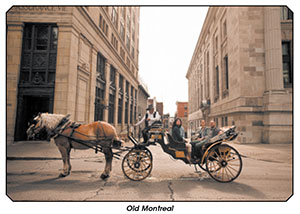 Montreal, a repository of both the hip and historic, is the second largest city in Canada and the largest French-speaking city outside Paris.
Montreal, a repository of both the hip and historic, is the second largest city in Canada and the largest French-speaking city outside Paris.
It's a cosmopolitan mix of cultures, global cuisines and boulevards from sporty to swank. The choices are exhilarating.
We registered at the luxe Hotel Le Crystal, which is located in the center of downtown. Sandwiched between the main shopping street and the convention center where the Montreal Canadiens play hockey, the property provides an indoor pool and a gym that tower over the city.
Our room lived like a spacious one-bedroom apartment with a flop-ready sectional couch, a kitchenette, two big-screen TVs and a glass shower fit for a queen.
Exciting nightlife took place all over the metropolis. We spent our first evening in Chinatown, which was buzzing with outdoor markets, stores, entertainment and so many enticing restaurants it was difficult to decide where to eat.
Wandering after a Cantonese dinner, we heard rockets exploding in the sky. Turned out, Montreal was the site of a months-long fireworks competition. Those pyrotechnics were the longest (half an hour!) and best we'd ever seen.
 The city has a packed event schedule. In fact, a jazz festival with legendary artists was underway, and we met Americans who had flown there specifically for it.
The city has a packed event schedule. In fact, a jazz festival with legendary artists was underway, and we met Americans who had flown there specifically for it.
The well-preserved public squares and colonial architecture of Old Montreal knocked our socks off. We were also impressed by the underground city of integrated business and shopping areas, designed in the modern era to keep the town humming during brutal winter weather.
Adirondacks Idyll
Just 45 minutes from the Canadian border lies the Adirondack Mountains town of Lake Placid, home to two Winter Olympics. We made a beeline to the gracious Mirror Lake Inn.
The inn, family owned since opening in 1924, provides a catalogue of opportunities for leisure: cooking classes, spa treatments, biking, tennis, paddling, canoeing, fishing, golfing, yoga and personal training with Olympians. Plus, there are indoor and outdoor pools and a private sandy beach. Winter sports include ice skating and snowshoeing.
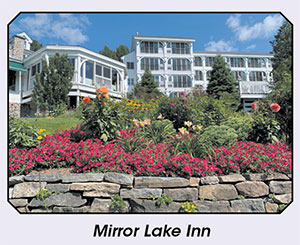 Shifting from activity to activity over three days, we felt like characters in "Dirty Dancing," the hit movie about a family spending their vacation at a New York resort.
Shifting from activity to activity over three days, we felt like characters in "Dirty Dancing," the hit movie about a family spending their vacation at a New York resort.
To recover from all that recreation, we savored bites galore.
Whether white-glove or casual, three restaurants with a view of the tranquil lake turned out remarkable dishes. Afternoon tea was served. And just-baked chocolate chip cookies were always piled high at the front desk, emblematic of the inn's warmth.
Ranging outside of downtown, we explored trending neighborhoods, including the Plateau, which features eclectic shops and venerable ethnic eateries next to
the sprawling Mount Royal Park. The landmark was designed by Frederick Law Olmstead, famed for New York's Central Park and Asheville's Biltmore Estate.
Montreal and the rest of our trek in Canada was extraordinary and unforgettable, but – after all that time - we were ready to head home. It took about an hour to get to the U.S. border at the New York State line. When we came face to face with the grandeur of the Adirondack Mountains, something suddenly occurred to us: A few more days couldn't hurt.
